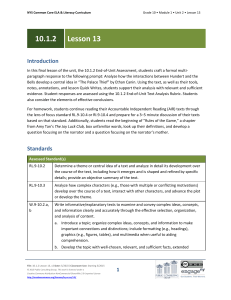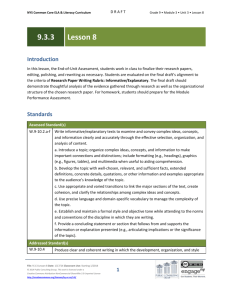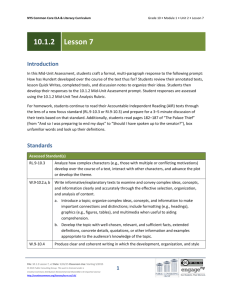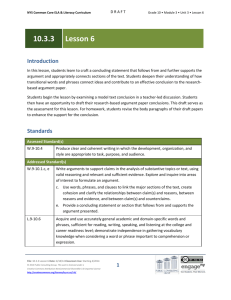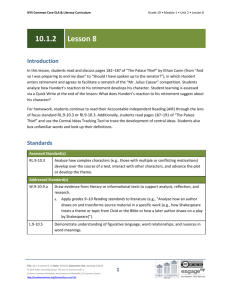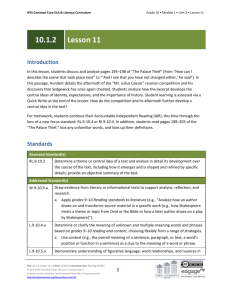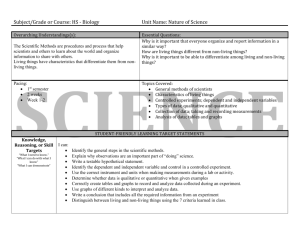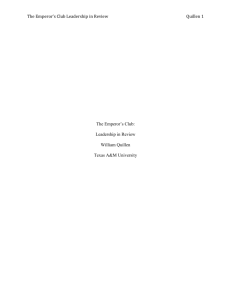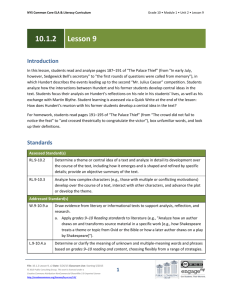Grade 10 ELA Module 1, Unit 2, Lesson 12
advertisement
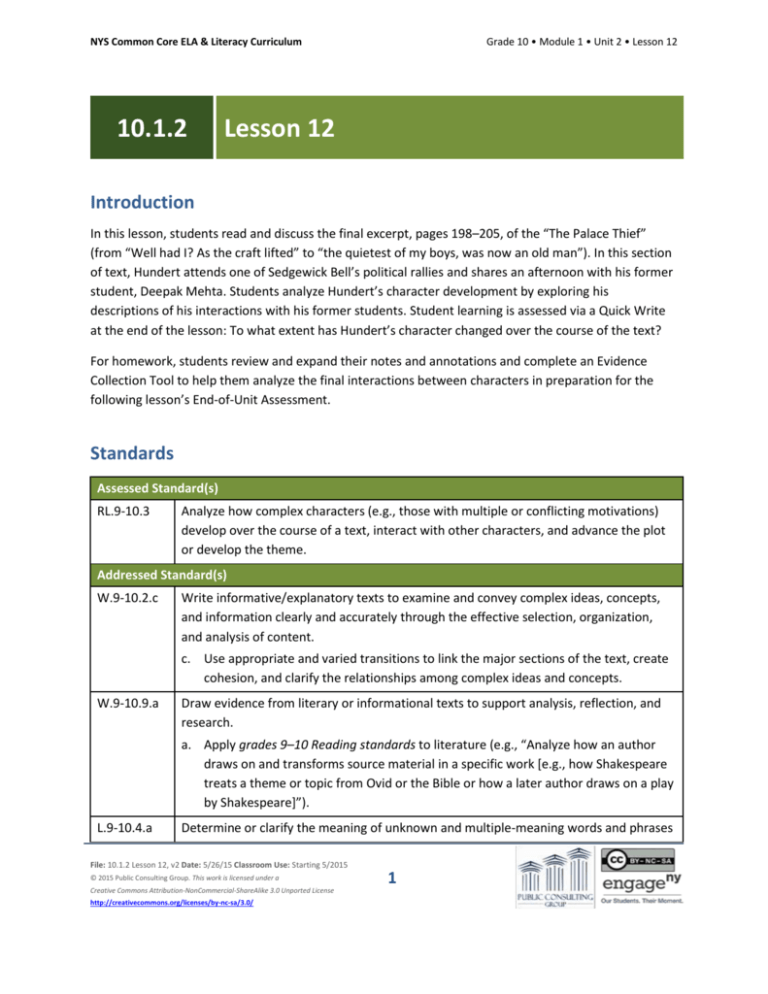
NYS Common Core ELA & Literacy Curriculum 10.1.2 Grade 10 • Module 1 • Unit 2 • Lesson 12 Lesson 12 Introduction In this lesson, students read and discuss the final excerpt, pages 198–205, of the “The Palace Thief” (from “Well had I? As the craft lifted” to “the quietest of my boys, was now an old man”). In this section of text, Hundert attends one of Sedgewick Bell’s political rallies and shares an afternoon with his former student, Deepak Mehta. Students analyze Hundert’s character development by exploring his descriptions of his interactions with his former students. Student learning is assessed via a Quick Write at the end of the lesson: To what extent has Hundert’s character changed over the course of the text? For homework, students review and expand their notes and annotations and complete an Evidence Collection Tool to help them analyze the final interactions between characters in preparation for the following lesson’s End-of-Unit Assessment. Standards Assessed Standard(s) RL.9-10.3 Analyze how complex characters (e.g., those with multiple or conflicting motivations) develop over the course of a text, interact with other characters, and advance the plot or develop the theme. Addressed Standard(s) W.9-10.2.c Write informative/explanatory texts to examine and convey complex ideas, concepts, and information clearly and accurately through the effective selection, organization, and analysis of content. c. Use appropriate and varied transitions to link the major sections of the text, create cohesion, and clarify the relationships among complex ideas and concepts. W.9-10.9.a Draw evidence from literary or informational texts to support analysis, reflection, and research. a. Apply grades 9–10 Reading standards to literature (e.g., “Analyze how an author draws on and transforms source material in a specific work [e.g., how Shakespeare treats a theme or topic from Ovid or the Bible or how a later author draws on a play by Shakespeare]”). L.9-10.4.a Determine or clarify the meaning of unknown and multiple-meaning words and phrases File: 10.1.2 Lesson 12, v2 Date: 5/26/15 Classroom Use: Starting 5/2015 © 2015 Public Consulting Group. This work is licensed under a Creative Commons Attribution-NonCommercial-ShareAlike 3.0 Unported License http://creativecommons.org/licenses/by-nc-sa/3.0/ 1 NYS Common Core ELA & Literacy Curriculum Grade 10 • Module 1 • Unit 2 • Lesson 12 based on grades 9–10 reading and content, choosing flexibly from a range of strategies. a. Use context (e.g., the overall meaning of a sentence, paragraph, or text; a word's position or function in a sentence) as a clue to the meaning of a word or phrase. Assessment Assessment(s) Student learning is assessed via a Quick Write at the end of the lesson. Students respond to the following prompt, citing textual evidence to support analysis and inferences drawn from the text. To what extent has Hundert’s character changed over the course of the text? High Performance Response(s) A High Performance Response should: Analyze Hundert’s character at the beginning of the story (e.g., In the beginning of the story Hundert is unable to live by his “own code of morals” (p. 172). For example, Hundert gives Sedgewick “an A on a quiz on which he had earned only a B” (p. 165) to ensure that he is able to participate in the first “Mr. Julius Caesar” competition. When Hundert discovers that Sedgewick is cheating during the competition, he attempts to make up for his wrongs by steering the competition toward Deepak Mehta, the most deserving student, using a question that is not on the outline, but he is dissatisfied with his efforts to maintain the “high ideals” that he values (p. 163). Later, when Senator Bell tells Hundert, “My son has told me a great deal about you, Mr. Hundert. If I were you, I’d remember that” (p. 173), Hundert decides to remain silent about Sedgewick’s cheating and instead accepts “an uneasy compact” (pp. 173–174).). Analyze Hundert’s character at the end of the story, noting how it has developed (e.g., In a final encounter with Sedgewick, Hundert finally confronts his former student by publicly denying Sedgewick’s statement that Hundert was his history teacher at a public high school rather than the elite private school, St. Benedict’s. Hundert’s statement goes unnoticed by the crowd, but he states, “It is enough to know that I did speak, and certainly a consolation that Sedgewick Bell realized, finally, that I would” (p. 203). Hundert’s words express his satisfaction that he has finally found the conviction to attempt to uphold the “high ideals” to which he aspires (p. 163).). Vocabulary Vocabulary to provide directly (will not include extended instruction) heinous (adj.) – very bad or evil; deserving of hate or contempt acquitting (v.) – deciding that someone is not guilty of a crime File: 10.1.2 Lesson 12, v2 Date: 5/26/15 Classroom Use: Starting 5/2015 © 2015 Public Consulting Group. This work is licensed under a Creative Commons Attribution-NonCommercial-ShareAlike 3.0 Unported License http://creativecommons.org/licenses/by-nc-sa/3.0/ 2 NYS Common Core ELA & Literacy Curriculum Grade 10 • Module 1 • Unit 2 • Lesson 12 intimated (v.) – said or suggested (something) in an indirect way incumbent (n.) – person who holds a specific office or position gleaned (v.) – learned, discovered, or found out, usually little by little or slowly populist (adj.) – of or related to a political party that claims to represent ordinary people rhetoric (n.) – the art or skill of speaking or writing formally and effectively especially as a way to persuade or influence people Vocabulary to teach (may include direct word work and/or questions) charisma (n.) – special charm or appeal that causes people to feel attracted and excited by someone (such as a politician) Additional vocabulary to support English Language Learners (to provide directly) convicting (v.) – proving that someone is guilty of a crime in a court of law fervor (n.) – a strong feeling of excitement and enthusiasm jubilation (n.) – great happiness or joy Lesson Agenda/Overview Student-Facing Agenda % of Lesson Standards & Text: Standards: RL.9-10.3, W.9-10.2.c, W.9-10.9.a, L.9-10.4.a Text: “The Palace Thief” from The Palace Thief by Ethan Canin, pages 198–205 Learning Sequence: 1. 2. 3. 4. 5. 6. Introduction of Lesson Agenda Homework Accountability Masterful Reading Reading Discussion Quick Write Closing 1. 2. 3. 4. 5. 6. 5% 10% 15% 45% 15% 10% Materials Student copies of the Short Response Rubric and Checklist (refer to 10.1.1 Lesson 1) Students copies of the 10.1 Common Core Learning Standards Tool (refer to 10.1.1 Lesson 1) File: 10.1.2 Lesson 12, v2 Date: 5/26/15 Classroom Use: Starting 5/2015 © 2015 Public Consulting Group. This work is licensed under a Creative Commons Attribution-NonCommercial-ShareAlike 3.0 Unported License http://creativecommons.org/licenses/by-nc-sa/3.0/ 3 NYS Common Core ELA & Literacy Curriculum Grade 10 • Module 1 • Unit 2 • Lesson 12 Copies of the 10.1.2 Evidence Collection Tool for each student Copies of the 10.1.2 End-of-Unit Assessment for each student Copies of the 10.1.2 End-of-Unit Text Analysis Rubric and Checklist for each student Learning Sequence How to Use the Learning Sequence Symbol Type of Text & Interpretation of the Symbol 10% no symbol Percentage indicates the percentage of lesson time each activity should take. Plain text indicates teacher action. Bold text indicates questions for the teacher to ask students. Italicized text indicates a vocabulary word. Indicates student action(s). Indicates possible student response(s) to teacher questions. Indicates instructional notes for the teacher. Activity 1: Introduction to Lesson Agenda 5% Begin by reviewing the agenda and the assessed standard for this lesson: RL.9-10.3. In this lesson, students analyze the last section of the short story, analyzing how Hundert’s character develops in the final pages of the text. Students look at the agenda. Activity 2: Homework Accountability 10% Instruct students to talk in pairs about how they applied focus standard RL.9-10.4 or RI.9-10.4 to their Accountable Independent Reading (AIR) text. Lead a brief share out on the previous lesson’s AIR homework assignment. Select several students (or student pairs) to explain how they applied the focus standard to their AIR text. Students (or student pairs) discuss how they applied the focus standard to their AIR text from the previous lesson’s homework. Instruct student pairs to share and discuss the vocabulary words they identified in the previous lesson’s homework. File: 10.1.2 Lesson 12, v2 Date: 5/26/15 Classroom Use: Starting 5/2015 © 2015 Public Consulting Group. This work is licensed under a Creative Commons Attribution-NonCommercial-ShareAlike 3.0 Unported License http://creativecommons.org/licenses/by-nc-sa/3.0/ 4 NYS Common Core ELA & Literacy Curriculum Grade 10 • Module 1 • Unit 2 • Lesson 12 Students may identify the following words: heinous, acquitting, intimated, incumbent, gleaned, populist, and rhetoric. Differentiation Consideration: Students may also identify the following words: convicting, fervor, and jubilation. Definitions are provided in the Vocabulary box in this lesson. Activity 3: Masterful Reading 15% Have students listen to a masterful reading of pages 198–205 of “The Palace Thief” (from “Well, had I? As the craft lifted” to “the quietest of my boys, was now an old man”). Ask students to listen for important details about Hundert’s interactions with Sedgewick and Deepak. Consider pausing several times during the masterful reading to allow students time to write down initial reactions and questions. Students follow along, reading silently. Differentiation Consideration: Consider posting or projecting the following guiding question to support students in their reading throughout this lesson: What do Hundert’s interactions with Sedgewick and Deepak suggest about Hundert’s character? Activity 4: Reading and Discussion 45% Instruct students to form small groups. Post or project each set of questions below for students to discuss. Instruct students to annotate for character development throughout the reading and discussion, using the code CD. This focused annotation supports students’ engagement with W.9-10.9.a, which addresses the use of textual evidence in writing. Instruct groups to reread pages 198–205 (from “Well had I? As the craft lifted” to “the quietest of my boys, was now an old man”) and answer the following questions before sharing out with the class. To what extent do Hundert’s reflections in the helicopter support Sedgewick’s statement, “And I see that you have not changed either” (p. 198)? Hundert’s reflections suggest that Sedgewick is correct and that he has not changed. After the first cheating incident, Hundert justified his decision to remain silent by explaining that the “necessities of a boys’ school” required him to ignore the cheating (p. 169). Now, Hundert rationalizes by reminding himself that he had “no proof” and assuring himself, “I indeed had File: 10.1.2 Lesson 12, v2 Date: 5/26/15 Classroom Use: Starting 5/2015 © 2015 Public Consulting Group. This work is licensed under a Creative Commons Attribution-NonCommercial-ShareAlike 3.0 Unported License http://creativecommons.org/licenses/by-nc-sa/3.0/ 5 NYS Common Core ELA & Literacy Curriculum Grade 10 • Module 1 • Unit 2 • Lesson 12 acted properly, for is it not the glory of our legal system that acquitting a guilty man is less heinous than convicting an innocent one?” (p. 198). What do Hundert’s reflections back at Woodmere suggest about Hundert’s character? Back at Woodmere, Hundert regrets that he did not expose Sedgewick’s cheating and he realizes that “a different ending would have better served us all” (p. 199). He recognizes, “conviction had failed me again” and regrets his lack of action. Hundert’s regret suggests that he is disappointed yet again that he did not meet his expectations for himself of living up to his own “high ideals” (p. 163). How does Hundert’s description of his interest in Sedgewick’s campaign develop Hundert’s character? Student responses may include: o o o Hundert’s interest in Sedgewick’s campaign suggests that he remains preoccupied with people from the past. He says, “Perhaps by then the boy had become an obsession for me” (p. 200), indicating that he spends much of his time following Sedgewick’s career. Hundert’s interest in Sedgewick’s campaign leads him to attend one of Sedgewick’s local appearances. On his way to the event, Hundert reflects, “Certainly I represented some sort of truth to him about himself” (p. 200), suggesting that he believes he is important in some way to Sedgewick. Traveling to Sedgewick’s campaign event, Hundert reflects on Sedgewick’s career and muses, “How far my boys would always stride upon the world’s stage, yet how dearly I would always hope to change them!” (p. 200). Hundert’s thoughts suggest that he still believes he can influence his former student. Differentiation Consideration: If students struggle, consider asking the following scaffolding question: How does Hundert’s reference the “power of [Sedgewick’s] voice and bearing“ (p. 200) clarify the meaning of the word charisma? Hundert suggests that Sedgewick’s voice and the way he carries himself is very appealing to people and he is confident that this power will win the support of the miners, so charisma must mean “a special charm or appeal that causes people to feel attracted and excited by someone.” Consider drawing students’ attention to the application of L.9-10.4.a through the process of using context to make meaning of unknown words. How does Hundert’s interaction with Sedgewick on the podium develop Hundert’s character? File: 10.1.2 Lesson 12, v2 Date: 5/26/15 Classroom Use: Starting 5/2015 © 2015 Public Consulting Group. This work is licensed under a Creative Commons Attribution-NonCommercial-ShareAlike 3.0 Unported License http://creativecommons.org/licenses/by-nc-sa/3.0/ 6 NYS Common Core ELA & Literacy Curriculum Grade 10 • Module 1 • Unit 2 • Lesson 12 Hundert’s interaction suggests that he is finally able to act on his convictions and “enforce [] [his] own code of morals” rather than be swept “summarily into [Sedgewick’s]” (p. 172). On the podium, when Hundert recognizes Sedgewick’s deception as he introduces Hundert as his history teacher from “Richmond Central High School” (p. 202), he returns to the microphone to announce, “I taught you at St. Benedict’s School in Woodmere, Virginia. Here is the blazer,” holding up his own jacket (p. 203). Even though Sedgewick turned off the microphone, Hundert recognizes his victory, saying, “It is enough to know that I did speak, and certainly a consolation that Sedgewick Bell realized, finally, that I would” (p. 203). To what extent does Hundert’s final interaction with Sedgewick contradict Heraclitus’s observation, “Man’s character is his fate” (p. 193)? Hundert’s actions on the stage suggest that one’s fate is not determined by one’s character. Throughout the story, the Bells have acted on the belief that Hundert “lacked the character” to confront them (p. 173), but on this occasion Hundert surprises Sedgewick by attempting to correct his misrepresentation publicly. Hundert’s actions suggest that his “fate” is not determined by his “character.” Despite past decisions and despite the momentum created by the cheering crowd, Hundert demonstrates that he is able to change. What does Hundert’s description of his life in Woodmere after the campaign rally suggest about his character? Hundert describes a peaceful, productive life after the campaign rally that contrasts sharply with his description of retirement prior to the rally, suggesting that he is more at peace. Hundert says he walks daily and has taken an interest in “the ancient Japanese civilizations” (p. 203). This is in contrast to his earlier description of retirement, when he said he “found [himself] with a great deal of time on [his] hands” and filled it by “replay[ing]” the second “Mr. Julius Caesar” competition in his mind (p. 199). Hundert notes Sedgewick’s “ascendance” but does not seem troubled by it (p. 204). Instead, he says that as a student of history he is not surprised, suggesting that he does not blame himself but accepts Sedgewick’s rise as part of a greater course of events. Lead a brief whole-class discussion of student responses. Activity 5: Quick Write 15% Instruct students to respond briefly in writing to the following prompt: To what extent has Hundert’s character changed over the course of the text? File: 10.1.2 Lesson 12, v2 Date: 5/26/15 Classroom Use: Starting 5/2015 © 2015 Public Consulting Group. This work is licensed under a Creative Commons Attribution-NonCommercial-ShareAlike 3.0 Unported License http://creativecommons.org/licenses/by-nc-sa/3.0/ 7 NYS Common Core ELA & Literacy Curriculum Grade 10 • Module 1 • Unit 2 • Lesson 12 Ask students to use this lesson’s vocabulary wherever possible in their written responses. Remind students to use the Short Response Rubric and Checklist to guide their written responses. Students listen and read the Quick Write prompt. Display the prompt for students to see, or provide the prompt in hard copy. Transition to the independent Quick Write. Students independently answer the prompt using evidence from the text. See the High Performance Response at the beginning of this lesson. Activity 6: Closing 10% Instruct students to take out their copies of the 10.1 Common Core Learning Standards Tool. Inform students that in this lesson they begin to work with a new substandard: W.9-10.2. Instruct students to individually read the standard on their tools and assess their familiarity with and mastery of it. Students read and assess their familiarity with substandard W.9-10.2.c. Instruct students to talk in pairs about what they think substandard W.9-10.2.c means. Lead a brief discussion about this standard. Student responses may include: o o The standard requires students to use words or phrases that will link different parts of a writing piece. The standard requires students to use words or phrases that will show how different ideas in a writing piece are connected. Instruct students to share with a partner some words or phrases that might help them create cohesion in a writing piece or demonstrate the relationship between ideas. Student responses may include: o o o Words such as similarly, also, and in the same way can show how ideas are alike. Words such as on the other hand, however, and nonetheless might show how ideas differ. Words such as first, in addition, later, and finally can link different parts of a writing piece and create a clear sequence of ideas. Distribute a copy of the 10.1.2 Evidence Collection Tool to each student. Read the directions on the tool aloud and remind students of their work with the 10.1.1 Evidence Collection Tool in 10.1.1 Lesson 6. Remind students that this tool helps students to collect and analyze evidence in the text and draw File: 10.1.2 Lesson 12, v2 Date: 5/26/15 Classroom Use: Starting 5/2015 © 2015 Public Consulting Group. This work is licensed under a Creative Commons Attribution-NonCommercial-ShareAlike 3.0 Unported License http://creativecommons.org/licenses/by-nc-sa/3.0/ 8 NYS Common Core ELA & Literacy Curriculum Grade 10 • Module 1 • Unit 2 • Lesson 12 connections across the evidence they collect. Explain that the tool helps students to prepare for the 10.1.2 End-of-Unit Assessment in Lesson 13. Explain that students should look for text evidence that will support their response to the 10.1.2 End-of-Unit Assessment prompt: Analyze how the interactions between Hundert and the Bells develop a central idea in “The Palace Thief.” Distribute copies of the 10.1.2 End-of-Unit Assessment, as well as the 10.1.2 End-of-Unit Text Analysis Rubric and Checklist. Read the End-of-Unit Assessment prompt and explain that students will write a multi-paragraph analysis in response to the prompt, using the rubric and checklist as a guide. Display and distribute the homework assignment. For homework, instruct students to prepare for the End-of-Unit Assessment by reviewing and expanding their notes and annotations and completing their Evidence Collection Tool. Remind students to use well-chosen evidence from the discussion and rereading to support their analysis and to practice using transitional words or phrases to clarify relationships among complex ideas as they write their connections. Students follow along. Homework Prepare for the 10.1.2 End-of-Unit Assessment by reviewing and expanding your notes and annotations and completing the 10.1.2 Evidence Collection Tool, using well-chosen evidence from the discussion and rereading to support your analysis. Use transitional words or phrases to clarify the relationships among the ideas you present. File: 10.1.2 Lesson 12, v2 Date: 5/26/15 Classroom Use: Starting 5/2015 © 2015 Public Consulting Group. This work is licensed under a Creative Commons Attribution-NonCommercial-ShareAlike 3.0 Unported License http://creativecommons.org/licenses/by-nc-sa/3.0/ 9 NYS Common Core ELA & Literacy Curriculum Grade 10 • Module 1 • Unit 2 • Lesson 12 10.1.2 Evidence Collection Tool (Side 1) Name: Class: Date: Directions: Select three quotes from “The Palace Thief” that address the focus question and write the quotes in the Key Detail space. Explain how each quote helps you to answer the focusing question in the Analysis space. Finally, use these notes to construct a response to the focusing question that connects your analysis of all three details in the Connections space. Focus Question: How do the interactions between Hundert and the Bells develop a central idea in “The Palace Thief”? Key Detail Analysis File: 10.1.2 Lesson 12, v2 Date: 5/26/15 Classroom Use: Starting 5/2015 © 2015 Public Consulting Group. This work is licensed under a Creative Commons Attribution-NonCommercial-ShareAlike 3.0 Unported License http://creativecommons.org/licenses/by-nc-sa/3.0/ 10 NYS Common Core ELA & Literacy Curriculum Grade 10 • Module 1 • Unit 2 • Lesson 12 10.1.2 Evidence Collection Tool (Side 2) Name: Class: Date: Connections: File: 10.1.2 Lesson 12, v2 Date: 5/26/15 Classroom Use: Starting 5/2015 © 2015 Public Consulting Group. This work is licensed under a Creative Commons Attribution-NonCommercial-ShareAlike 3.0 Unported License http://creativecommons.org/licenses/by-nc-sa/3.0/ 11 NYS Common Core ELA & Literacy Curriculum Grade 10 • Module 1 • Unit 2 • Lesson 12 10.1.2 End-of-Unit Assessment Text-Based Response Your Task: Based on your close reading of Ethan Canin’s “The Palace Thief,” write a well-developed, text-based response to the following prompt: Analyze how the interactions between characters in “The Palace Thief” develop a central idea of the text. Your response will be assessed using the 10.1.2 End-of-Unit Text Analysis Rubric. Guidelines: Be sure to: Closely read the prompt Respond directly to all parts of the prompt Cite strong and thorough textual evidence to support your analysis Organize your ideas and evidence in a cohesive and coherent manner Use precise language and domain specific language appropriate to the task CCSS: RL.9-10.2, RL.9-10.3, W.9-10.2.a, b, W.9-10.4, L.9-10.1, L.9-10.2.c Commentary on the Task: This task measures RL.9-10.2 because it demands that students: Determine a theme or central idea of a text and analyze in detail its development over the course of the text, including how it emerges and is shaped and refined by specific details; provide an objective summary of the text. This task measures RL.9-10.3 because it demands that students: Analyze how complex characters (e.g., those with multiple or conflicting motivations) develop over the course of a text, interact with other characters, and advance the plot or develop the theme. This task measures W.9-10.2.a and b because it demands that students: Write informative/explanatory texts to examine and convey complex ideas, concepts, and information clearly and accurately through the effective selection, organization, and analysis of content. o Introduce a topic; organize complex ideas, concepts and information to make important connections and distinctions o Develop the topic with well-chosen, relevant, and sufficient facts, extended definitions, concrete details, quotations, or other information and examples appropriate to the audience's knowledge of the topic. File: 10.1.2 Lesson 12, v2 Date: 5/26/15 Classroom Use: Starting 5/2015 © 2015 Public Consulting Group. This work is licensed under a Creative Commons Attribution-NonCommercial-ShareAlike 3.0 Unported License http://creativecommons.org/licenses/by-nc-sa/3.0/ 12 NYS Common Core ELA & Literacy Curriculum Grade 10 • Module 1 • Unit 2 • Lesson 12 This task measures W.9-10.4 because it demands that students: Produce clear and coherent writing in which the development, organization, and style are appropriate to task, purpose, and audience. This task measures L.9-10.1 because it demands that students: Demonstrate command of the conventions of standard English grammar and usage when writing or speaking. This task measures L.9-10.2.c because it demands that students: Demonstrate command of the conventions of standard English capitalization, punctuation, and spelling when writing. o Spell correctly. File: 10.1.2 Lesson 12, v2 Date: 5/26/15 Classroom Use: Starting 5/2015 © 2015 Public Consulting Group. This work is licensed under a Creative Commons Attribution-NonCommercial-ShareAlike 3.0 Unported License http://creativecommons.org/licenses/by-nc-sa/3.0/ 13 NYS Common Core ELA & Literacy Curriculum Grade 10 • Module 1 • Unit 2 • Lesson 12 10.1.2 End-of-Unit Text Analysis Rubric / (Total points) Criteria 4 – Responses at this Level: 3 – Responses at this Level: 2 – Responses at this Level: 1 – Responses at this Level: Content and Analysis Precisely determine the central idea of a text and skillfully analyze its development by providing precise and sufficient examples of the central idea’s emergence and refinement; (when necessary) provide a concise and accurate objective summary of a text. Accurately determine the central idea of a text and analyze its development by providing relevant and sufficient examples of the central idea’s emergence and refinement; (when necessary) provide an accurate objective summary of a text. Determine the central idea of a text and with partial accuracy, analyze its development by providing relevant but insufficient examples of a central idea’s emergence and refinement; (when necessary) provide a partially accurate and somewhat objective summary of a text. Inaccurately determine the central idea of a text. Provide no examples or irrelevant and insufficient examples of the central idea’s emergence and refinement; (when necessary) provide a lengthy, inaccurate, or subjective summary of a text. Skillfully analyze how complex characters develop over the course of a text, interact with other characters, and advance the plot or develop the theme. Accurately analyze how complex characters develop over the course of a text, interact with other characters, and advance the plot or develop the theme. With partial accuracy, analyze how complex characters develop over the course of a text, interact with other characters, and advance the plot or develop the theme. Inaccurately analyze how complex characters develop over the course of a text, interact with other characters, and advance the plot or develop the theme. The extent to which the response determines a central idea of a text and analyzes its development over the course of the text, including how it emerges and is shaped and refined by specific details; provides an objective summary of a text. CCSS.ELA-Literacy.RL.9-10.2 Determine a central idea of a text and analyze in detail its development over the course of the text, including how it emerges and is shaped and refined by specific details; provide an objective summary of the text. Content and Analysis The extent to which the response analyzes how complex characters develop over the course of a text, interact with other characters, and advance the plot or develop the theme. CCSS.ELA-Literacy.RL.9-10.3 Analyze how complex characters (e.g. those with multiple or conflicting motivations) develop over the course of a text, interact with other characters, and advance the plot or develop the theme. File: 10.1.2 Lesson 12, v2 Date: 5/26/15 Classroom Use: Starting 5/2015 © 2015 Public Consulting Group. This work is licensed under a Creative Commons Attribution-NonCommercial-ShareAlike 3.0 Unported License http://creativecommons.org/licenses/by-nc-sa/3.0/ 14 NYS Common Core ELA & Literacy Curriculum Grade 10 • Module 1 • Unit 2 • Lesson 12 Criteria 4 – Responses at this Level: 3 – Responses at this Level: 2 – Responses at this Level: 1 – Responses at this Level: Command of Evidence and Reasoning Thoroughly and skillfully develop the topic with well-chosen, relevant, and sufficient facts, extended definitions, concrete details, quotations, or other information and examples appropriate to the audience’s knowledge of the topic. (W.9-10.2.b) Develop the topic with relevant and sufficient facts, extended definitions, concrete details, quotations, or other information and examples appropriate to the audience’s knowledge of the topic. (W.9-10.2.b) Partially develop the topic with weak facts, extended definitions, details, quotations, or other information and examples appropriate to the audience’s knowledge of the topic. (W.9-10.2.b) Minimally develop the topic, providing few or irrelevant facts, extended definitions, details, quotations, or other information and examples appropriate to the audience’s knowledge of the topic. (W.9-10.2.b) Skillfully introduce a topic; effectively organize complex ideas, concepts, and information to make important connections and distinctions; when useful to aiding comprehension, skillfully include formatting, graphics, and multimedia. (W.9-10.2.a) Introduce a topic; organize complex ideas, concepts, and information to make important connections and distinctions; when useful to aiding comprehension, include formatting, graphics, and multimedia. (W.910.2.a) Somewhat effectively introduce a topic; organize complex ideas, concepts, and information, making limited connections and distinctions; when useful to aiding comprehension, somewhat effectively include formatting, graphics, and multimedia. (W.9-10.2.a) Lack a clear topic; illogically arrange ideas, concepts and information, failing to make connections and distinctions; when useful to aiding comprehension, ineffectively include formatting, graphics, and multimedia. (W.9-10.2.a) The extent to which the response develops the topic with wellchosen, relevant, and sufficient facts, extended definitions, concrete details, quotations, or other relevant information and examples appropriate to the audience’s knowledge of the topic. CCSS.ELA-Literacy.W.9-10.2 Write informative/explanatory texts to examine and convey complex ideas, concepts, and information clearly and accurately through the effective selection, organization, and analysis of content. CCSS.ELA-Literacy.W.9-10.2.b Develop the topic with wellchosen, relevant, and sufficient facts, extended definitions, concrete details, quotations, or other information and examples appropriate to the audience’s knowledge of the topic. Coherence, Organization, and Style The extent to which the response introduces a topic, organizes complex ideas, concepts, and information to make important connections and distinctions; when useful to aiding File: 10.1.2 Lesson 12, v2 Date: 5/26/15 Classroom Use: Starting 5/2015 © 2015 Public Consulting Group. This work is licensed under a Creative Commons Attribution-NonCommercial-ShareAlike 3.0 Unported License http://creativecommons.org/licenses/by-nc-sa/3.0/ 15 NYS Common Core ELA & Literacy Curriculum Criteria Grade 10 • Module 1 • Unit 2 • Lesson 12 4 – Responses at this Level: 3 – Responses at this Level: 2 – Responses at this Level: 1 – Responses at this Level: Consistently demonstrate clear and coherent writing in which the development, organization, and style thoroughly and skillfully address the task, purpose, and audience. Demonstrate clear and coherent writing in which the development, organization, and style are appropriate to the task, purpose, and audience. Inconsistently demonstrate clear and coherent writing in which the development, organization, and style are appropriate to the task, purpose, and audience. Rarely demonstrate clear and coherent writing in which the development, organization, and style are appropriate to the task, purpose, and audience. comprehension, includes formatting, graphics, and multimedia. CCSS.ELA-Literacy.W.9-10.2 Write informative/explanatory texts to examine and convey complex ideas, concepts, and information clearly and accurately through the effective selection, organization, and analysis of content. CCSS.ELA-Literacy.W.9-10.2.a Introduce a topic; organize complex ideas, concepts, and information to make important connections and distinctions; include formatting (e.g., headings), graphics (e.g., figures, tables), and multimedia when useful to aiding comprehension. Coherence, Organization, and Style The extent to which the response demonstrates clear and coherent writing in which the development, organization, and style are appropriate to task, purpose, and audience. CCSS.ELA-Literacy.W.9-10.4 Produce clear and coherent writing in which the development, organization, and style are appropriate to task, purpose, and audience. File: 10.1.2 Lesson 12, v2 Date: 5/26/15 Classroom Use: Starting 5/2015 © 2015 Public Consulting Group. This work is licensed under a Creative Commons Attribution-NonCommercial-ShareAlike 3.0 Unported License http://creativecommons.org/licenses/by-nc-sa/3.0/ 16 NYS Common Core ELA & Literacy Curriculum Grade 10 • Module 1 • Unit 2 • Lesson 12 Criteria 4 – Responses at this Level: 3 – Responses at this Level: 2 – Responses at this Level: 1 – Responses at this Level: Control of Conventions Demonstrate skillful command of conventions with no grammar or usage errors. Demonstrate command of conventions with occasional grammar or usage errors that do not hinder comprehension. Demonstrate partial command of conventions with several grammar or usage errors that hinder comprehension. Demonstrate insufficient command of conventions with frequent grammar or usage errors that make comprehension difficult. Spell correctly with no errors. (L.910.2.c) Often spell correctly with occasional errors that do not hinder comprehension. (L.9-10.2.c) Occasionally spell correctly with several errors that hinder comprehension. (L.9-10.2.c) Rarely spell correctly with frequent errors that make comprehension difficult. (L.9-10.2.c) The extent to which the response demonstrates command of the conventions of standard English grammar and usage. CCSS.ELA-Literacy.L.9-10.1 Demonstrate command of the conventions of standard English grammar and usage when writing or speaking. Control of Conventions The extent to which the response is spelled correctly. CCSS.ELA-Literacy.L.9-10.2 Demonstrate command of the conventions of standard English capitalization, punctuation, and spelling when writing. CCSS.ELA-Literacy.L.9-10.2.c Spell correctly. A response that is a personal response and makes little or no reference to the task or text can be scored no higher than a 1. A response that is totally copied from the text with no original writing must be given a 0. A response that is totally unrelated to the task, illegible, incoherent, blank, or unrecognizable as English must be scored as a 0. File: 10.1.2 Lesson 12, v2 Date: 5/26/15 Classroom Use: Starting 5/2015 © 2015 Public Consulting Group. This work is licensed under a Creative Commons Attribution-NonCommercial-ShareAlike 3.0 Unported License http://creativecommons.org/licenses/by-nc-sa/3.0/ 17 NYS Common Core ELA & Literacy Curriculum Grade 10 • Module 1 • Unit 2 • Lesson 12 10.1.2 End-of-Unit Text Analysis Checklist Assessed Standards: Does my writing… Content and Analysis ✔ Identify a central idea from the text and analyze its development? (RL.9-10.2) Provide examples to support analysis of the emergence and refinement of the central idea? (RL.9-10.2) If necessary, include a brief summary of the text to frame the development and refinement of the central idea? (RL.910.2) Analyze how complex characters develop over the course of a text, interact with other characters, and advance the plot or develop the theme? (RL.9-10.3) Command of Evidence and Reasoning Develop the topic with well-chosen and relevant textual evidence? (W.9-10.2.b) Coherence, Organization, and Style Introduce a topic? (W.9-10.2.a) Organize complex ideas, concepts, and information to make important connections and distinctions? (W.9-10.2.a) When useful to aiding comprehension, include formatting, graphics, and multimedia? (W.9-10.2.a) Demonstrate clear and coherent writing in which the development, organization, and style that are appropriate to task, purpose, and audience? (W.9-10.4) Demonstrate command of the conventions of standard English grammar and usage? (L.9-10.1) Demonstrate accurate spelling? (L.9-10.2.c) Control of Conventions File: 10.1.2 Lesson 12, v2 Date: 5/26/15 Classroom Use: Starting 5/2015 © 2015 Public Consulting Group. This work is licensed under a Creative Commons Attribution-NonCommercial-ShareAlike 3.0 Unported License http://creativecommons.org/licenses/by-nc-sa/3.0/ 18
